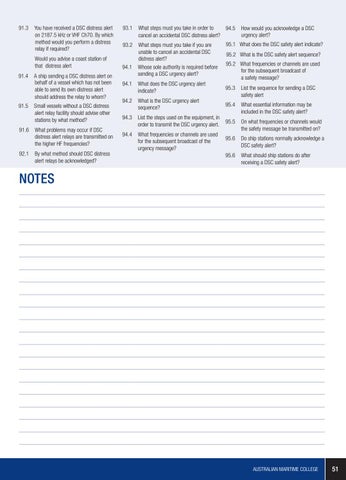91.3
You have received a DSC distress alert on 2187.5 kHz or VHF Ch70. By which method would you perform a distress relay if required? would you advise a coast station of that distress alert
91.4
A ship sending a DSC distress alert on behalf of a vessel which has not been able to send its own distress alert should address the relay to whom?
91.5 Small vessels without a DSC distress alert relay facility should advise other stations by what method? 91.6 What problems may occur if DSC distress alert relays are transmitted on the higher HF frequencies? 92.1 By what method should DSC distress alert relays be acknowledged?
93.1
What steps must you take in order to 94.5 How would you acknowledge a DSC urgency alert? cancel an accidental DSC distress alert?
93.2 What steps must you take if you are unable to cancel an accidental DSC distress alert? 94.1 Whose sole authority is required before sending a DSC urgency alert? 94.1 What does the DSC urgency alert indicate? 94.2 What is the DSC urgency alert sequence? 94.3 List the steps used on the equipment, in order to transmit the DSC urgency alert. 94.4 What frequencies or channels are used for the subsequent broadcast of the urgency message?
95.1 what does the DSC safety alert indicate? 95.2 what is the DSC safety alert sequence? 95.2 what frequencies or channels are used for the subsequent broadcast of a safety message? 95.3 List the sequence for sending a DSC safety alert 95.4 What essential information may be included in the DSC safety alert? 95.5 On what frequencies or channels would the safety message be transmitted on? 95.6 Do ship stations normally acknowledge a DSC safety alert? 95.6 What should ship stations do after receiving a DSC safety alert?
NOTES
AUSTRALIAN MARITIME COLLEGE
51
